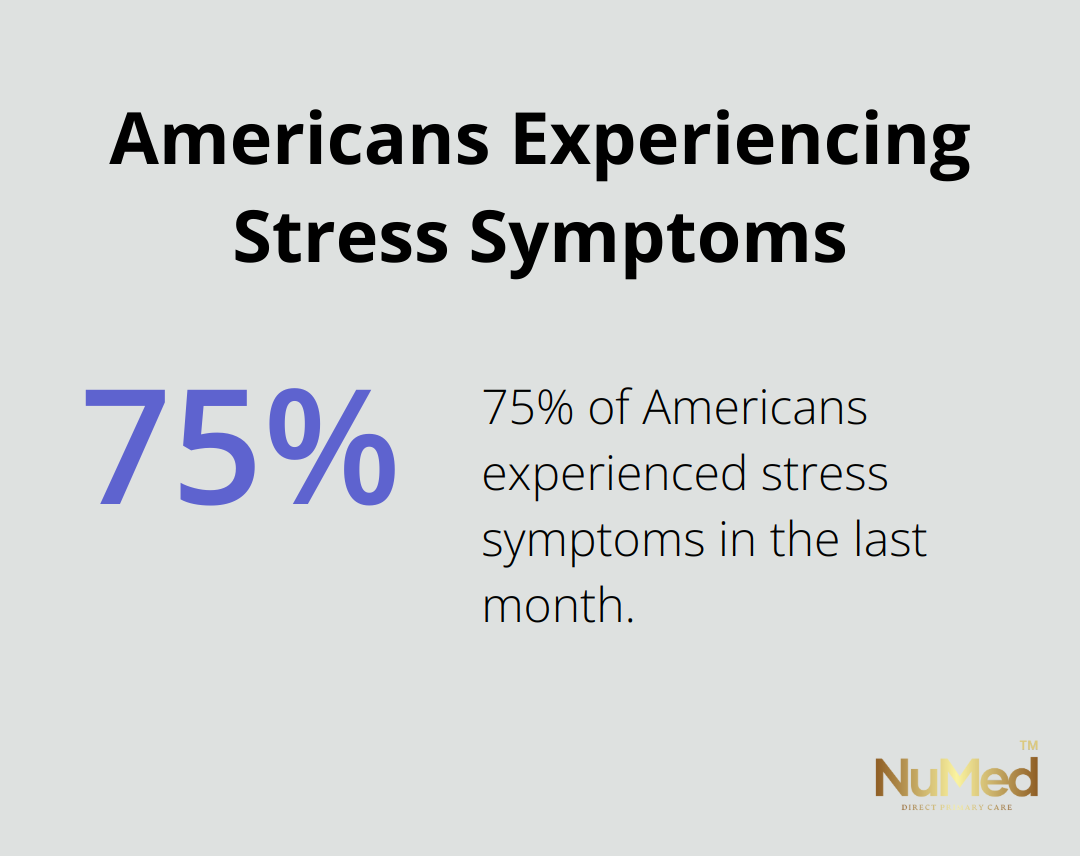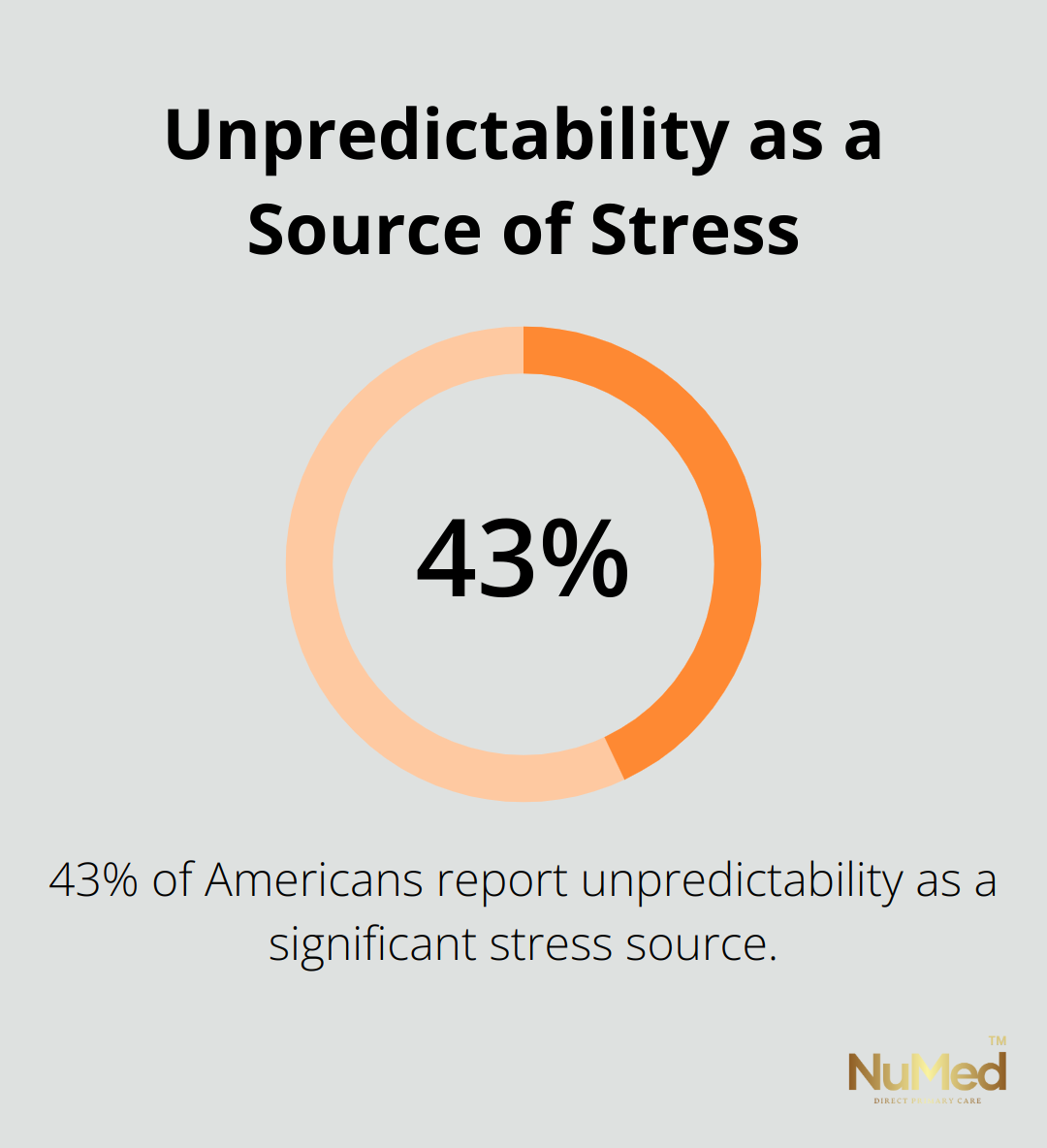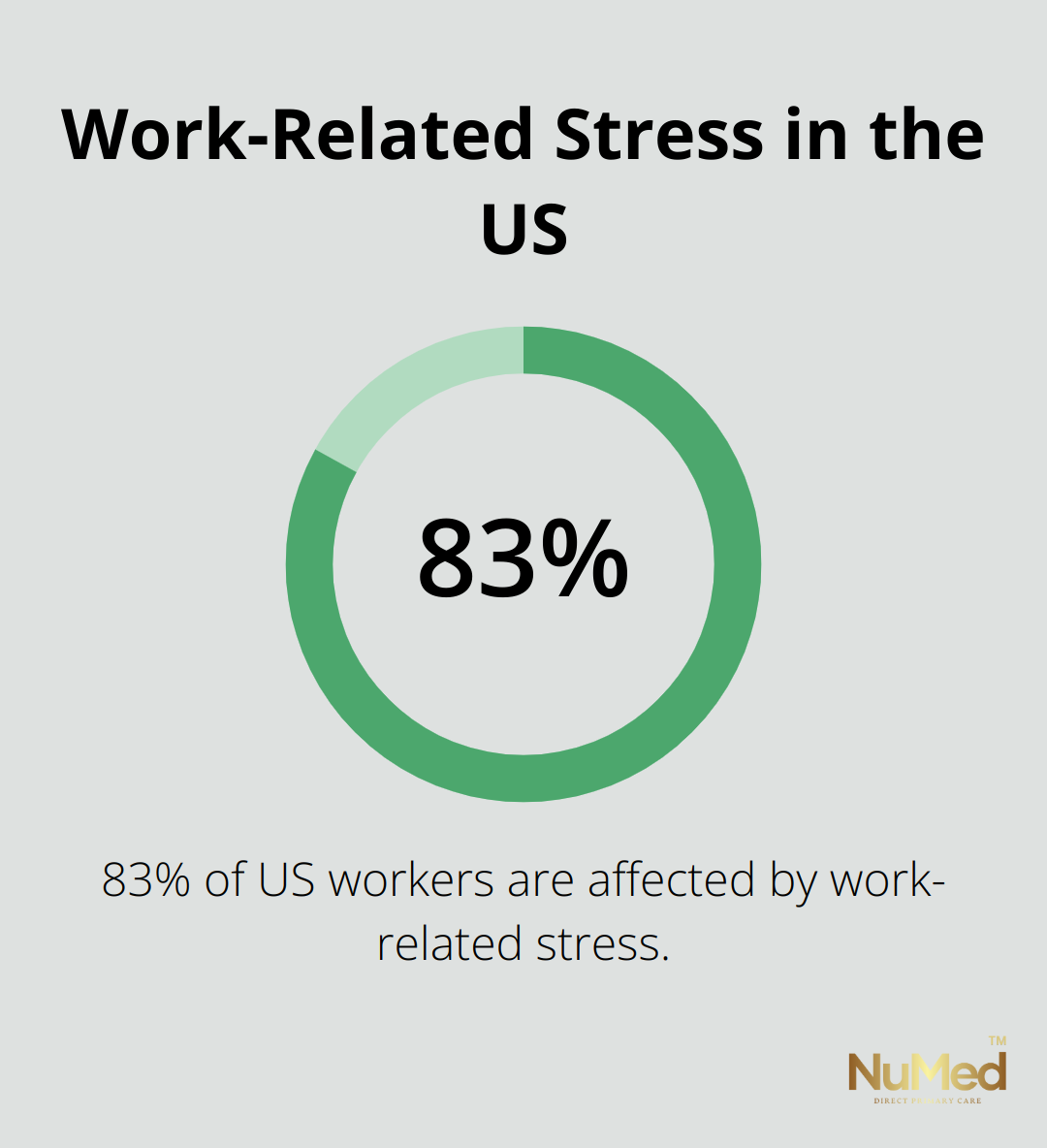At NuMed DPC, we understand that stress affects everyone differently. The Transactional Model of Stress offers a comprehensive framework for understanding how individuals perceive and cope with stressful situations.
This model emphasizes the dynamic interaction between a person and their environment, highlighting the importance of cognitive appraisal in determining stress responses. By exploring this model, we can gain valuable insights into managing stress more effectively in various aspects of our lives.
How the Transactional Model of Stress Works
The Transactional Model of Stress offers a practical framework for understanding our interactions with stressful situations. Psychologists Richard S. Lazarus and Susan Folkman developed this model in 1984, breaking down the stress process into key components that we can actively manage.
Threat Evaluation
The first step in the stress process involves threat evaluation, known as primary appraisal. We quickly assess whether a situation poses a risk to our well-being. A sudden work deadline might trigger an immediate stress response, while a minor traffic delay might not.
Around 75% of Americans reported to the American Psychological Association that they experienced a physical or mental symptom of stress in the last month. Learning to accurately evaluate threats can help us reduce unnecessary stress responses and focus our energy on genuine challenges.

Resource Assessment
After identifying a stressor, we move to secondary appraisal. This step involves taking stock of our available resources and coping strategies. We ask ourselves: Do we have the skills, support, or time to handle the situation?
A study in the Journal of Personality and Social Psychology found that individuals who perceived themselves as having adequate resources to cope with stressors reported lower stress levels and better overall well-being.
Coping Strategy Implementation
Based on our appraisals, we employ coping strategies. These typically fall into two categories:
- Problem-focused strategies: These aim to change the stressful situation directly (e.g., creating a study schedule for an upcoming exam).
- Emotion-focused strategies: These help manage the emotional impact of stress (e.g., practicing deep breathing exercises).
A survey by the American Institute of Stress revealed that 63% of US workers report high levels of work-related stress. Consciously choosing appropriate coping strategies can significantly reduce this burden. Time management techniques can serve as an effective problem-focused strategy for workplace stress, while mindfulness practices offer emotion-focused relief.
Continuous Reevaluation
The final component of the Transactional Model involves reappraisal. As we navigate a stressful situation, we continuously reassess both the threat and our ability to cope. This ongoing process allows us to adjust our strategies as needed, making our stress response more flexible and effective.
Understanding and applying the Transactional Model of Stress empowers us to take a more active role in managing our stress levels. This approach aligns with preventive care practices and addresses the root causes of health issues. Through personalized strategies and ongoing support, we can build resilience and improve our overall well-being in the face of life’s many stressors.
Now that we understand how the Transactional Model of Stress works, let’s explore the various factors that influence our stress appraisal process.
What Shapes Our Stress Response?
Our stress response varies from person to person. Multiple factors influence how we perceive and react to stressors. Understanding these elements can help us manage stress more effectively and improve our overall well-being.
Personality Traits and Past Experiences
Personality traits significantly impact our stress response. A study in the Journal of Personality and Social Psychology found that individuals with high neuroticism levels often perceive more situations as threatening and experience higher stress levels. Conversely, those with high optimism and resilience often view challenges as growth opportunities rather than threats.
Past experiences also shape our stress response. Successfully navigating similar stressful situations in the past increases our confidence in handling current challenges. This underscores the importance of building a repertoire of positive coping experiences.
Social Support and Cultural Context
Our social environment and cultural background influence our stress appraisal. A meta-analysis revealed that individuals with strong social support networks report lower stress levels and better mental health outcomes. This highlights the value of cultivating and maintaining supportive relationships.
Cultural context also affects our stress perception. A study in the Journal of Cross-Cultural Psychology found that collectivist cultures often view stress as a shared experience, leading to different coping strategies compared to individualistic cultures.
Situational Factors: Timing, Control, and Predictability
The nature of the stressor plays a significant role in our stress response. Unexpected, uncontrollable, or unpredictable stressors tend to elicit stronger stress responses. A survey by the American Psychological Association found that 43% of Americans report unpredictability as a significant source of stress in their lives.

Developing strategies to increase our sense of control and predictability can help mitigate stress. This might involve creating structured routines, setting realistic goals, or breaking large tasks into smaller, manageable steps.
Beliefs and Self-Efficacy
Our beliefs about ourselves and our abilities profoundly impact our stress response. Self-efficacy (our belief in our ability to handle challenges) is particularly important. Research shows that individuals with high self-efficacy tend to view stressful situations as challenges to master rather than threats to avoid.
Cultivating a growth mindset and building self-efficacy through gradual exposure to challenges and celebrating small victories can significantly enhance our stress resilience.
Understanding these factors allows us to take a more proactive approach to stress management. Recognizing the elements that shape our stress response enables us to develop targeted strategies to build resilience and maintain better overall health. In the next section, we’ll explore how to apply the Transactional Model of Stress in real-life situations, providing practical tools for managing stress in various contexts.
Practical Stress Management in Everyday Life
Conquering Workplace Stress
Work-related stress affects 83% of US workers, according to the American Institute of Stress. The Transactional Model of Stress provides effective tools to combat this issue.

Identify your primary workplace stressors first. These might include tight deadlines, difficult colleagues, or overwhelming workloads. Next, assess your available resources, such as supportive coworkers, flexible work hours, or relevant skills.
Implement targeted coping strategies based on your assessment. For a heavy workload, prioritize tasks and delegate when possible (problem-focused approach). Take short meditation breaks to manage anxiety (emotion-focused strategy).
Many companies now offer stress management programs. These programs can reduce stress levels by up to 25%. If your workplace doesn’t offer one, consider suggesting it to HR.
Tackling Academic Stress and Test Anxiety
Research findings suggest that there exists a negative correlation between the academic performance of university students and their level of test anxiety.
When facing an important exam, evaluate the threat level. Ask yourself: Is this a make-or-break test, or just one of many assessments? Then, assess your resources. Consider factors like preparation time, access to study materials, and support from teachers or study groups.
Create a structured study schedule as an effective problem-focused strategy. Practice relaxation techniques before the exam as an emotion-focused approach. Students who use a combination of these strategies show a 15% improvement in test performance.
Managing Health-Related Stress
Chronic illness often leads to high stress levels, affecting 60% of adults with such conditions, according to the American Psychological Association.
Start by accurately assessing the threat when dealing with health-related stress. Consult healthcare professionals to understand your condition and its implications. Evaluate your resources, including access to quality healthcare, supportive family, and financial means for treatment.
Adhere to treatment plans (problem-focused strategy) and join support groups (emotion-focused approach). Patients who actively engage in both types of coping strategies report better quality of life and lower stress levels.
Navigating Relationship Conflicts
Relationship stress significantly impacts well-being, with 36% of Americans citing relationships as a major stress source (American Psychological Association).
When facing relationship conflicts, evaluate the severity of the issue. Is it a minor disagreement or a fundamental problem? Assess your resources, such as communication skills or access to relationship counseling.
Use open communication and problem-solving (problem-focused strategies) combined with empathy and emotional regulation (emotion-focused approaches). Couples who use these strategies report higher relationship satisfaction and lower stress levels.
The Transactional Model of Stress, when applied to these common life situations, enables more effective stress management. As you practice these principles, you’ll become better equipped to handle life’s challenges.
Final Thoughts
The Transactional Model of Stress offers a powerful framework for understanding and managing stress in our daily lives. This model highlights the dynamic interaction between individuals and their environment, emphasizing the role of cognitive appraisal in shaping stress responses. Individual differences, such as personality traits, past experiences, and cultural context, significantly influence how we perceive and respond to stressors.
The practical applications of the Transactional Model of Stress extend to various aspects of life, including work, academics, health, and relationships. This model enables us to identify specific stressors, assess available resources, and implement targeted coping strategies. At NuMed Direct Primary Care, we recognize the profound impact of stress on physical and emotional health.
Our approach aligns with the principles of the Transactional Model of Stress, focusing on preventive care and addressing root causes of health issues. We empower our patients to take an active role in managing their stress and overall health through personalized care and a range of services (including functional medicine and health coaching). The Transactional Model of Stress provides valuable insights for building resilience and thriving in the face of life’s many challenges.
















